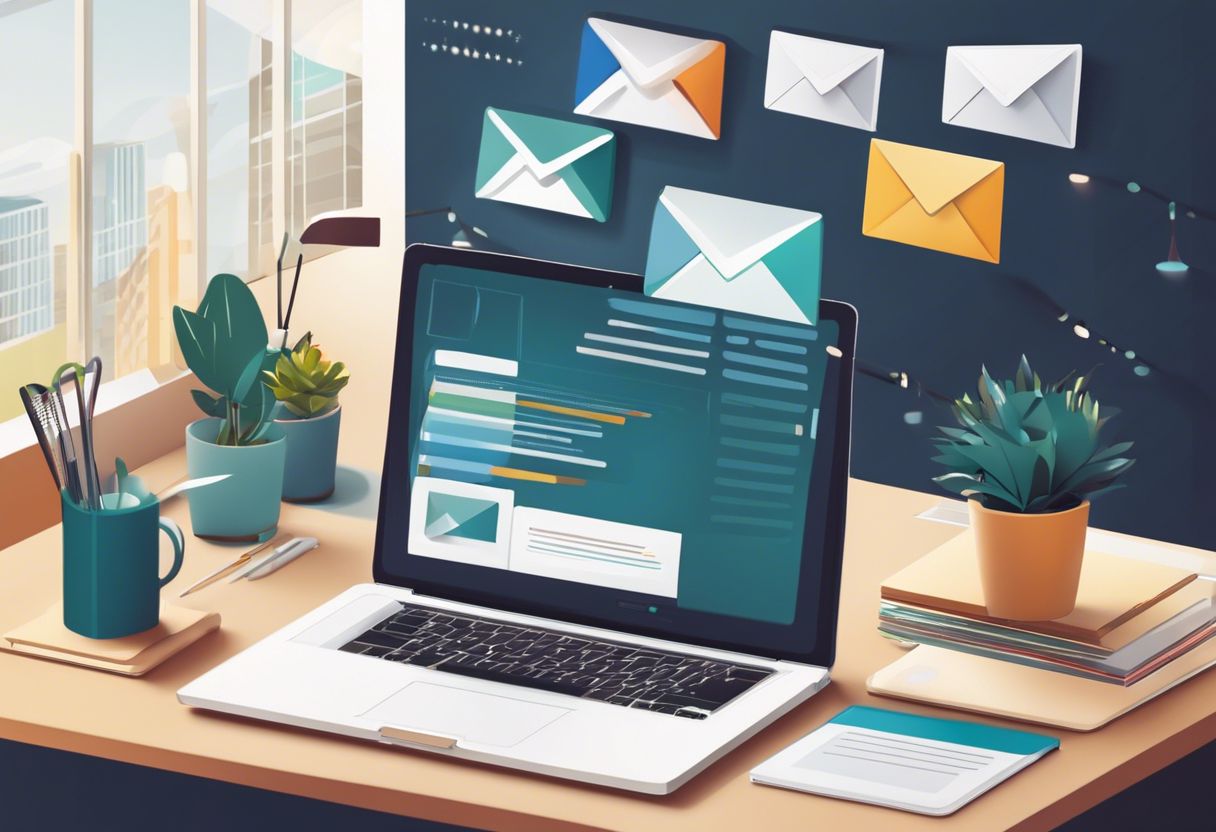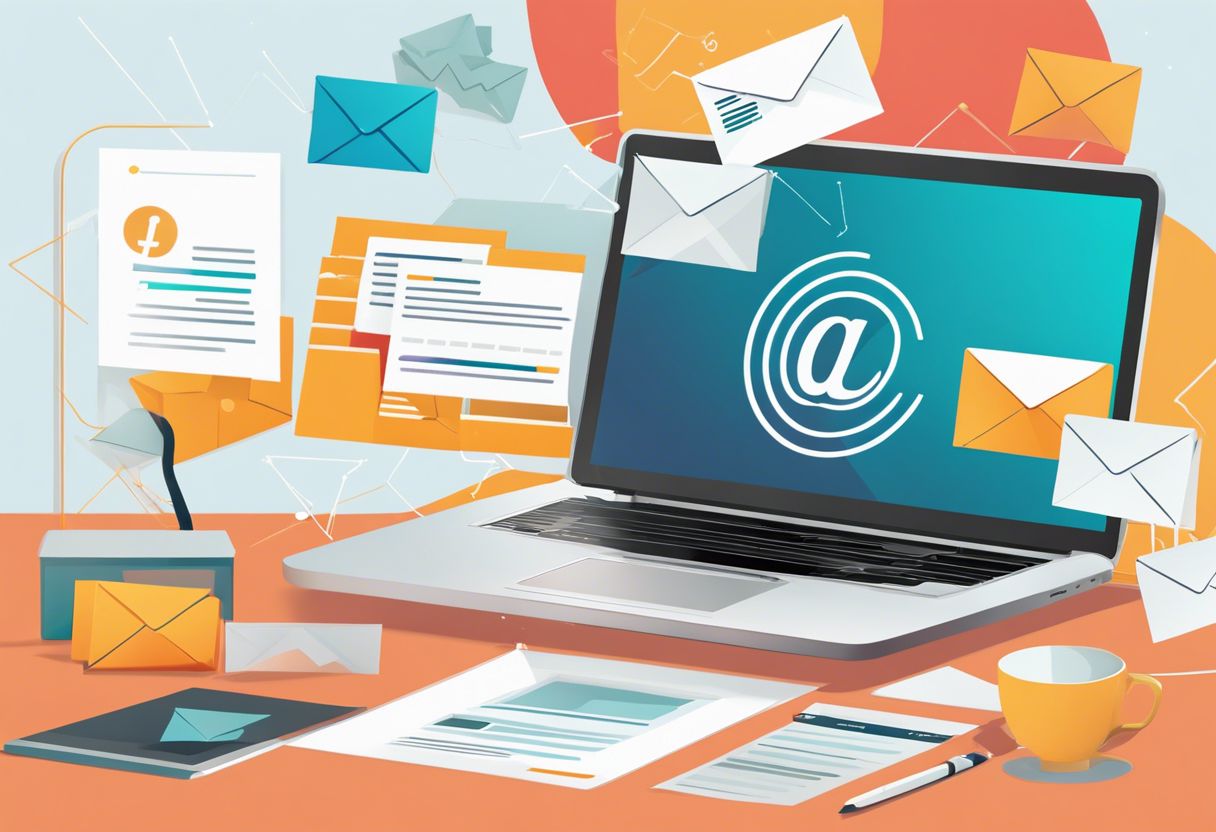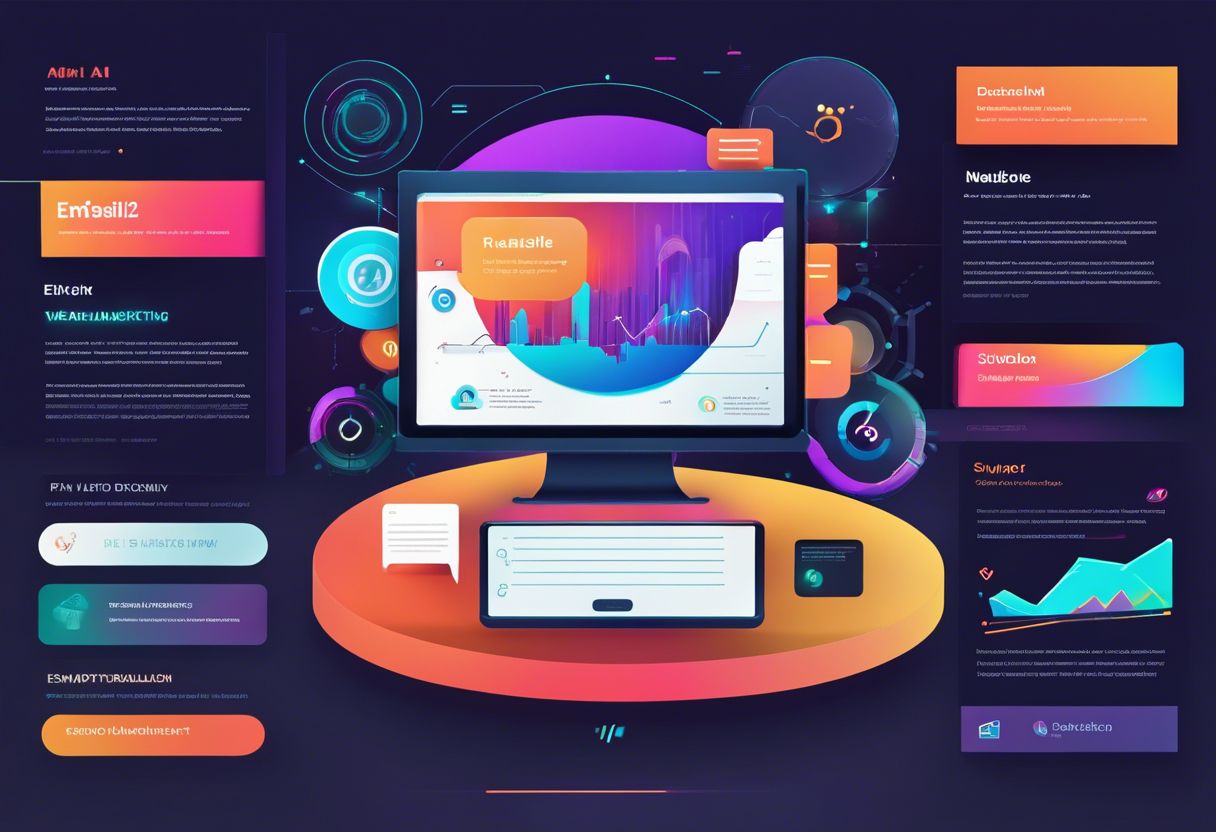Email Marketing for Websites: Strategies that Work

Email marketing is when websites send out emails to people who have signed up to hear from them. It’s a big part of helping businesses do well, with over 90% of companies saying it’s very important.
We need good plans for our email marketing so that we can share information and connect with more people.
Knowing the basics is like having a map for our journey. Email marketing means sending out messages that matter to each person, putting subscribers into groups, writing subject lines that grab attention, making sure emails look great on phones, and always checking if things can be better.
We’ll also look at smart ways to use email like sending them automatically at the perfect time, adding fun stuff in emails that people can click on or play with right inside the message and sharing stories or photos from happy customers.
Getting your timing right matters too! Sending an email once a week might work best but send too many and you could lose subscribers—69% say they would unsubscribe if they get swamped by emails!
Keeping folks interested and coming back is another trick. We can bring back those who haven’t been around in a while using special emails just for them or rewarding loyal fans with nice surprises.
To make sure we’re doing our best, we test different ideas (like A/B testing), watch how well our campaigns are doing through metrics such as Clickthrough Rate and Open Rate, and then change what we’re doing based on what the numbers tell us.
But when sending all these cool emails, it’s super important to follow rules like CAN-SPAM Act and GDPR so everyone’s information stays safe—and this helps keep our messages out of spam folders too!
The future of email marketing looks exciting with new trends popping up all the time which means there’s always something new to learn.
Let’s explore some strategies together so we can be pros at email marketing!
Understanding the Basics of Email Marketing

Email marketing is a powerful tool for businesses to connect with their audience through personalized messages delivered directly to their inbox. It’s essential to understand the basics of email marketing and its importance in building strong customer relationships and driving business growth.
What is email marketing?

Email marketing lets us talk to lots of people at once. It’s like sending out a big party invitation, but for our business. Think of it as getting the word out about sales or new stuff we’re excited to share straight into someone’s inbox.
We use it because it really works. It helps us sell more and get to know our customers better.
We send letters called newsletters or email campaigns straight from our computer to theirs. This way, when they open their email, they see news from us, maybe a special deal just for them, or an invite to check out something cool on our website.
And because we can send so many emails at the same time, we reach more people in less time.
It’s great because it makes customers feel special with messages meant just for them. And not only does this help with selling things right now; it also builds trust so they’ll remember us and come back later on too.
Email promotions lead to more folks knowing about our brand which leads to loyalty and even better –– sales!
The importance of email marketing strategies

Email marketing strategies are at the heart of connecting with people who visit our website. We know that throwing messages out into the world isn’t enough; we must reach the right person with the right words at just the right time.
With a strong strategy, we can turn one-time visitors into loyal customers.
Our approach to email marketing focuses on building solid relationships. After all, it’s not just about selling products, it’s also about creating value for our subscribers so they look forward to every message from us.
This means understanding what makes them tick and offering content that resonates with their needs and interests.
To make sure we’re on target, we stay sharp by testing different designs and copy to see what works best. We track everything from how many people open our emails to which links get clicked most often.
These insights help us refine our tactics continuously—an essential part of staying relevant in ever-changing markets.
Let’s move forward and put these strategies into action as we craft effective email marketing campaigns.
Crafting Effective Email Marketing Strategies

Crafting effective email marketing strategies involves personalizing your messages, segmenting your subscribers, creating compelling subject lines, optimizing emails for mobile devices, and testing and refining your copy, design, and buttons.
These techniques can help improve engagement and conversion rates for your email campaigns.
Personalize your messages

We know that sending the same message to every subscriber just doesn’t cut it anymore. To really stand out, we tailor our emails to fit each person’s interests and needs. Imagine getting an email that has your name on it and talks about things you actually like – that feels pretty special, right? That’s what personalized emails do; they make subscribers feel valued and not just another number in a list.
Personalized messages help us build trust with you. We use what we know about our customers to create content that clicks with them. It could be special deals or updates on stuff they’ve shown interest in before.
About 61% of marketers say mixing personalization with automated emails leads to great success. So let’s put the spotlight on who our readers are, making sure our next email feels like it was sent from a friend.
Now let’s think about how else we can reach you effectively…
Segment your subscribers

When crafting effective email marketing strategies, segmenting your subscribers is crucial. This means breaking your email list into smaller, targeted groups based on specific factors like demographics and user behavior.
By doing this, you can personalize content to better suit the interests of each group. For instance, you can use demographic data such as age or location to send tailored campaigns that resonate with different segments of your audience.
Furthermore, segmenting subscribers allows for more targeted and effective messaging based on their preferences and needs.
Segmentation also enables marketers to categorize subscribers according to their engagement levels or purchase history. By understanding these categories, businesses can create tailored campaigns designed to re-engage inactive subscribers or entice loyal customers with special offers meant specifically for them.
In addition to boosting engagement and conversions through personalized content categories using segmentation techniques bring tangible benefits in improving website traffic and amplifying the impact of compelling subject lines.
Create compelling subject lines

Crafting compelling subject lines is crucial for engaging your audience and improving open rates. By incorporating trending topics and timely headlines, you can pique curiosity and encourage recipients to click on your emails.
It’s important to be clear, concise, and engaging while accurately reflecting the email’s content in your subject lines. Use language that grabs attention and offers value to entice recipients to open your emails.
To create catchy subject lines, consider personalization, avoiding overuse of the word “free”, and using a sense of urgency or curiosity. Additionally, crafting irresistible email headers that generate excitement can significantly impact open rates and engagement.
Optimize emails for mobile devices

Crafting compelling subject lines is just the beginning. Now, let’s make sure your emails are optimized for mobile devices. With over 60% of emails being opened on smartphones, it’s crucial to ensure your messages look great and function well on smaller screens.
Mobile-friendly design not only enhances user experience but also boosts open rates, click-through rates, inbox placement, engagement, and conversion rates. Employ responsive design that adapts seamlessly to various screen sizes and functionalities.
Consider the visual layout and formatting carefully; concise copy, clear call-to-action buttons, and easy navigation are essential for mobile users. By leveraging A/B testing techniques specific to mobile optimization, you can refine your email content according to what resonates best with smartphone users – all contributing towards a successful email marketing strategy that truly connects with your audience while keeping up with evolving trends in digital communication.
Test and refine copy, design, and buttons

After optimizing emails for mobile devices, it’s crucial to focus on testing and refining elements like copy, design, and buttons to ensure maximum impact. Here are some strategies to effectively refine your email marketing campaigns:
- A/B Testing for Copy: Experiment with different variations of email content to identify the most compelling language and messaging that resonates with your audience. This includes testing subject lines, body copy, and calls-to-action.
- Design Optimization: Refine the visual aspects of your emails by testing different layouts, color schemes, images, and overall design elements to gauge which resonates best with your recipients.
- Button Performance Testing: Evaluate the effectiveness of call-to-action buttons by testing variations in size, color, text, and placement within the email to prompt desired actions from the subscribers.
- Email Copy Refinement: Continuously refine your email copy by analyzing what kind of content generates higher engagement rates among your subscribers. This involves tweaking tone, length, and style of the messages.
- Comprehensive AB Testing Strategies: Implement a structured approach to A/B testing that covers various aspects such as subject line variations, call-to-action button testing, and refining email campaigns based on observed results.
- Crafting Effective Email Design: Develop visually appealing yet functional designs for emails that align with your brand while also catering to the preferences of your audience.
- Compelling Email Content: Create captivating and relevant content that drives engagement and encourages action from recipients while maintaining consistency with your brand voice and messaging strategy.
- Optimizing Email Performance: Leverage data insights gained from A/B tests to continually optimize email performance through iterative improvements in copywriting, design layout, and call-to-action strategies.
- Calltoaction Button Testing: Experiment with different styles of call-to-action buttons within emails to drive optimal click-through rates and conversion outcomes.
- Refining Email Campaigns: Continuously fine-tune entire email campaigns based on A/B test results aimed at enhancing open rates, click-through rates, and overall campaign effectiveness.
Advanced Email Marketing Techniques

Utilize automation to send timely campaigns and leverage interactivity in emails to engage subscribers. Incorporate user-generated content and connect with social media for expanded reach, ensuring that your email marketing strategies are cutting-edge and effective.
Use automation to send timely campaigns

We understand the value of sending timely and targeted email campaigns to your contacts. By incorporating email marketing automation, you can leverage advanced techniques to schedule and send personalized messages at the right time.
Automation tools allow for prescheduling sends based on your audience’s behaviors and preferences, ensuring that they receive relevant content when they are most likely to engage with it.
With automated email software, you can set up behavioral triggers to deliver messages tailored to specific actions taken by your subscribers, ultimately enhancing the effectiveness of your campaigns.
Furthermore, targeted audience data can be utilized to segment your subscribers and automate the delivery of content that resonates with their interests or past interactions with your website.
Leverage interactivity in emails
Incorporating interactive elements in your emails can significantly boost engagement and enhance the user experience. By integrating features like image carousels, clickable CTAs, or interactive surveys, you can create a more immersive and personalized experience for your subscribers.
These advanced techniques not only capture attention but also encourage active participation, resulting in higher click-through ratesand overall campaign effectiveness. Leveraging interactivity in your email campaigns is an innovative way to connect with your audience and drive meaningful interactions that can lead to increased conversions.
– Incorporate user-generated content
Incorporate user-generated content
In our advanced email marketing techniques, we’ve found that incorporating user-generated content (UGC) can be a game-changer. It’s an effective way to create engaging email campaigns that resonate with your audience and drive results.
UGC not only enhances engagement but also builds trust, ultimately leading to higher conversions. By leveraging UGC in your email marketing strategies, you can tap into the power of real examples, templates, and creator lists provided by your own customers or followers.
It’s important to note that UGC is revolutionizing social media and eCommerce, and it has the potential to do the same for your email marketing efforts. As small business owners seeking innovative ways to connect with your audience, integrating UGC into your email campaigns can help you stand out from the competition while fostering a sense of community around your brand.
Connect with social media for expanded reach
When it comes to expanding your digital reach, integrating social media with email marketing can be a game-changer for small business owners. By synchronizing these efforts, you not only increase online engagement but also enhance your marketing outreach by tapping into a wider audience.
The link between social media and email marketing is crucial for boosting brand promotion, customer connection, and targeted promotions.
By connecting with social media platforms through email marketing, you can effectively expand your audience and facilitate content sharing. This integration enables seamless user interaction across platforms while building and maintaining your mailing list effectively.
Timing and Frequency Matters

Determining the optimal timing and frequency for your email campaigns is crucial to reaching your audience at the right time without overwhelming them. Find out the best practices for email timing and how to determine the optimal frequency for your specific audience.
Learn how to maximize the impact of your email marketing efforts by reading more about this important aspect of successful strategies.
Best practices for email timing
When planning email campaigns, it’s important to consider the timing and frequency of your emails to optimize customer engagement and conversion rates. Here are some best practices for email timing:
- Base your email cadence on the customer life cycle to ensure that your emails align with their journey and needs at each stage.
- Adjust the frequency of your emails based on broader marketing goals, such as promoting a new product or driving traffic to specific content, to ensure better engagement and response from your audience.
- Choose the best day and time to send emails based on your target audience’s behavior and preferences. Running tests can help determine the optimal timing for maximum impact.
- Optimize email frequency for increased engagement, loyalty, and revenue by considering not only how often you send emails but also when you send them.
- Conduct A/B testing to figure out the ideal email frequency for your specific audience, taking into account factors such as open rates, click-through rates, and conversions.
Determining the optimal frequency for your audience
Determining the best email frequency involves testing and analyzing. Here’s a step-by-step guide to finding the optimal frequency for your audience:
- Test different frequencies: Start by sending emails at varied intervals to see which frequency yields the best engagement.
- Analyze unsubscribe rates: Monitor how often subscribers opt-out to identify if the frequency is overwhelming them.
- Track audience resonance: Measure how different frequencies impact open rates, click-through rates, and overall response from your audience.
- Consider subscriber preferences: Collect feedback or conduct surveys to understand how often your subscribers want to hear from you.
- Adjust based on data insights: Use metrics such as open rates, click-through rates, and conversion rates to refine your email frequency strategy.
- Apply industry insights: Incorporate findings from industry benchmarks and studies regarding optimal email frequency.
- Personalize timing: Factor in the nature of your business and the preferences of your specific audience when finalizing your email frequency strategy.
Re-engagement and Retention Strategies

Utilizing winback emails effectively, implementing loyalty reward emails, and strategizing to re-engage inactive subscribers are crucial for maintaining a healthy email list and maximizing the impact of your campaigns.
Learn more about these key strategies to boost your email marketing effectiveness.
Strategies for re-engaging inactive subscribers
We understand the challenge of reactivating inactive subscribers. It’s essential to engage and retain contacts who have stopped interacting with our emails. Here are some strategies that work:
- Craft compelling subject lines in re – engagement emails to grab the attention of inactive subscribers.
- Use personalized messages to remind inactive subscribers why they initially signed up and encourage them to engage again.
- Implement winback emails effectively, offering incentives or special offers to entice inactive subscribers back.
- Leverage user – generated content to create a sense of community and reconnect with inactive subscribers.
- Incorporate interactive elements in re – engagement emails, such as surveys or polls, to encourage interaction.
- Utilize A/B testing to refine re – engagement campaigns for optimal effectiveness.
- Analyze key metrics such as open rates and click-through rates to track the success of re-engagement efforts.
Utilizing winback emails effectively
When it comes to re-engaging inactive subscribers, utilizing win-back emails effectively can be a game-changer for small businesses. Reactivation emails are designed to reignite the interest of relapsed customers and encourage them to make repeat purchases.
By leveraging customer data insights and tailoring compelling content, businesses can implement win-back email campaigns that resonate with their audience. With 45% of recipients reading subsequent emails after receiving a re-engagement email, this strategy holds significant potential for customer retention and boosting customer lifetime value.
Implementing loyalty reward emails is another effective way to keep your customers engaged over time. By offering exclusive incentives or personalized offers based on past interactions, businesses can foster a sense of appreciation and incentivize repeat purchases.
Implementing loyalty reward emails
After we’ve effectively utilized winback emails, it’s essential to focus on implementing loyalty reward emails as part of our re-engagement and retention strategies. These customer retention emails play a vital role in maintaining and increasing consumer loyalty.
By rewarding highly engaged customers through our email marketing strategy, we can reinforce long-term relationships with them while also driving repeat purchases. This not only strengthens our engagement with existing customers but also offers cost-effectiveness and increased customer engagement, all key elements in building a successful small business.
By providing these practical benefits through the implementation of loyalty reward emails, we are moving towards achieving our goal of preserving and growing consumer loyalty within our audience segment.
Analyzing and Improving Email Campaigns

To ensure the success of your email marketing efforts, it’s crucial to analyze and continuously improve your campaigns. A/B testing can help you find out what works best for your audience, while tracking key metrics will provide valuable insights to adjust your strategies accordingly.
Understanding and decoding analytics is essential to crafting effective email campaigns that drive results.
A/B testing to improve campaign performance
When we talk about A/B testing, we simply mean comparing two versions of a marketing campaign to see which one performs better. This is an essential strategy for improving your email marketing success.
With A/B testing, you can test variations of your emails and identify what resonates best with your audience. By doing this, you can improve open rates, click-through rates, and ultimately conversions.
A/B testing allows us to gain insights into customer preferences and behavior. It’s a way to make informed decisions based on data rather than assumptions. By consistently running these tests and analyzing the results, we can refine our email campaigns for optimal performance using split testing or marketing experiments.
Tracking key metrics for success
Now, let’s delve into the essential aspect of tracking key metrics for success in email marketing. Analyzing email campaigns is crucial for understanding their effectiveness. By monitoring key performance indicators such as open rates, clickthrough rates, and conversion rates, we can measure the impact of our emails.
Additionally, keeping an eye on unsubscribe rates and overall return on investment allows us to assess the campaign’s performance accurately.
Measuring these metrics gives us valuable insights that enable us to make data-driven decisions. It helps optimize subject lines to improve open rates and refine campaign strategies for better overall results.
Adjusting strategies based on data insights
After tracking key metrics for success, we can utilize the insights gained to adjust our email marketing strategies. By studying conversion rates, customer engagement, and behavioral analysis, we gain valuable data-driven marketing insights.
Analytical tools help us understand which emails perform best and why. We shouldn’t underestimate the power of personalized targeted emails that result in higher click-through rates and improved customer retention.
Additionally, understanding email performance metrics allows us to optimize campaigns for better results.
How to Decode Analytics to Understand and Improve Your Email Campaigns
Adjusting strategies based on data insights is crucial for improving email campaigns. Analyzing email campaign metrics and KPIsprovides valuable insights, allowing us to understand customer behavior and optimize our email marketing efforts.
By deciphering customer intent through data analysis, we can tailor our messages to better resonate with our audience, thus improving the effectiveness of our campaigns.
Understanding and tracking email marketing metrics is fundamental for gauging campaign success and return on investment (ROI). Keeping a close eye on engagement data allows us to comprehend audience interactions, refine our content, and design more effective calls-to-action.
Staying Compliant and Avoiding Spam Filters

Understanding the rules and regulations of email marketing compliance, such as CAN-SPAM and GDPR, is crucial for maintaining deliverability. Learn how to avoid spam filters and ensure your emails reach your audience by reading more in our comprehensive guide on Email Marketing for Websites: Strategies that Work.
Understanding CAN-SPAM and GDPR compliance
Complying with the CAN-SPAM Act means making sure your commercial emails are honest, not misleading, and that they’re clearly identified as advertisements. It also requires giving recipients the option to opt out of receiving future emails from you.
Similarly, adhering to GDPR regulations is essential for businesses handling data from European customers. This includes obtaining explicit consent before sending marketing emails and respecting the privacy rights of individuals by providing them with control over their personal information.
To maintain compliance with these email marketing regulations, it’s important to keep updated on any changes in legislation that might affect your marketing activities. By understanding and abiding by these laws, you can build trust with your audience while avoiding potential legal issues.
Tips to avoid spam filters and maintain deliverability
To ensure that your emails reach your audience’s inbox, it’s important to follow best practices for maintaining deliverability and avoiding spam filters. Here are some tips for small business owners:
- Use double opt – in confirmation to ensure that subscribers actively choose to receive your emails. This helps maintain high engagement and reduces the risk of being marked as spam.
- Monitor and maintain your IP reputation by consistently sending relevant content and adhering to email marketing regulations such as CAN-SPAM and GDPR compliance.
- Avoid trigger words or misleading subject lines that may trigger content filtering or be flagged as spam by email service providers.
- Encourage subscribers to add your email address to their contact list to improve the chances of your emails reaching their inbox.
The Future of Email Marketing

As technology continues to evolve, the future of email marketing holds opportunities for AI-powered personalization, interactive content, and even more sophisticated automation. Stay ahead of the curve by reading our blog to learn about the latest trends and innovations in email marketing!
Predictions for email marketing trends and innovations
The future of email marketing is all about putting the customer first. Predictions indicate that personalization will be key, with machine learning algorithms generating tailored content and recommendations for individual recipients.
Furthermore, integrating interactivity into emails is expected to gain traction as a trend in 2024, engaging subscribers in new and exciting ways. Sustainable email marketing is also set to take center stage, reflecting a growing focus on environmentally friendly practices within the industry.
Moving forward, automation and personalized strategies are poised to play crucial roles in boosting engagement and effectiveness. With digital innovations driving its development, email marketing will continue evolving and expanding to cater to changing consumer behaviors and expectations.
Conclusion

In conclusion, email marketing offers businesses a powerful way to connect with their audience and drive meaningful engagement. By crafting personalized messages, leveraging automation, and analyzing campaign performance, businesses can optimize their email marketing strategies for success.
Staying compliant with regulations and adapting to future trends is essential in harnessing the full potential of email marketing. With effective implementation of these strategies, small business owners can enhance their online presence and achieve tangible results through targeted communication with their customers.
To further enhance your email campaigns, learn how to decipher the numbers by visiting our detailed guide on how to decode analytics and understand & improve your email marketing strategies.
FAQs
1. How can I grow my email list for website marketing?
You can grow your email list by using sign-up forms on your website, offering incentives such as freebies or discounts, and promoting your newsletter on social media.
2. What are the best times to send marketing emails for better engagement?
The best times to send marketing emails are typically mid-week, around mid-morning or early afternoon. However, it’s essential to test and analyze the engagement patterns of your specific audience.
3. What type of content works well for email marketing campaigns?
Effective content for email marketing includes personalized messages, valuable information about new products or services, exclusive offers for subscribers, and engaging visuals like images or videos.
4. How can I prevent my marketing emails from ending up in spam folders?
To avoid getting flagged as spam, use clear subject lines, authenticate your domain with SPF/DKIM records, regularly clean your email list, and avoid using spam-triggering words in the content.
5. Is it necessary to have a professional design for marketing emails?
While professional designs can enhance the appeal of marketing emails, simple and well-formatted text-based emails with compelling content can also be effective for engaging readers.


